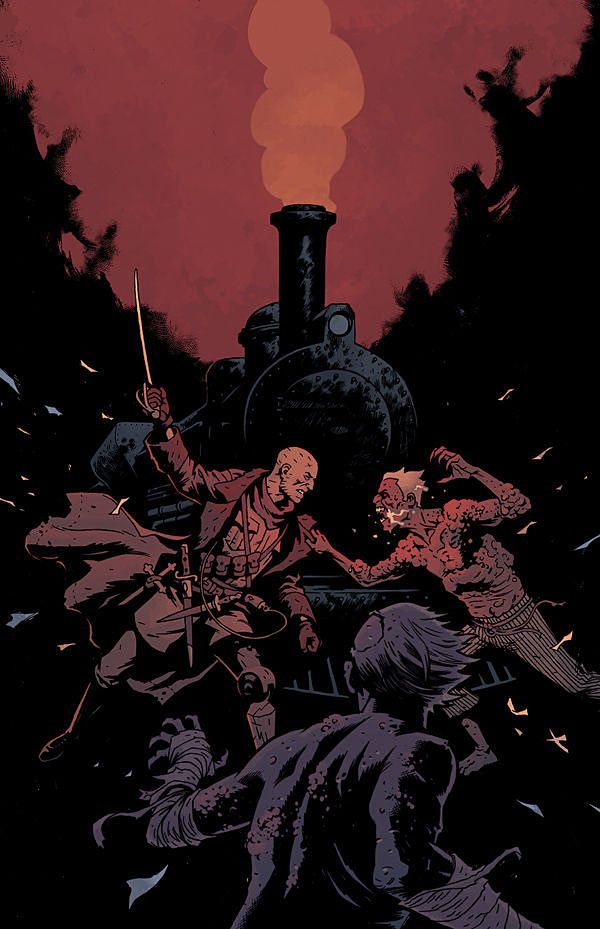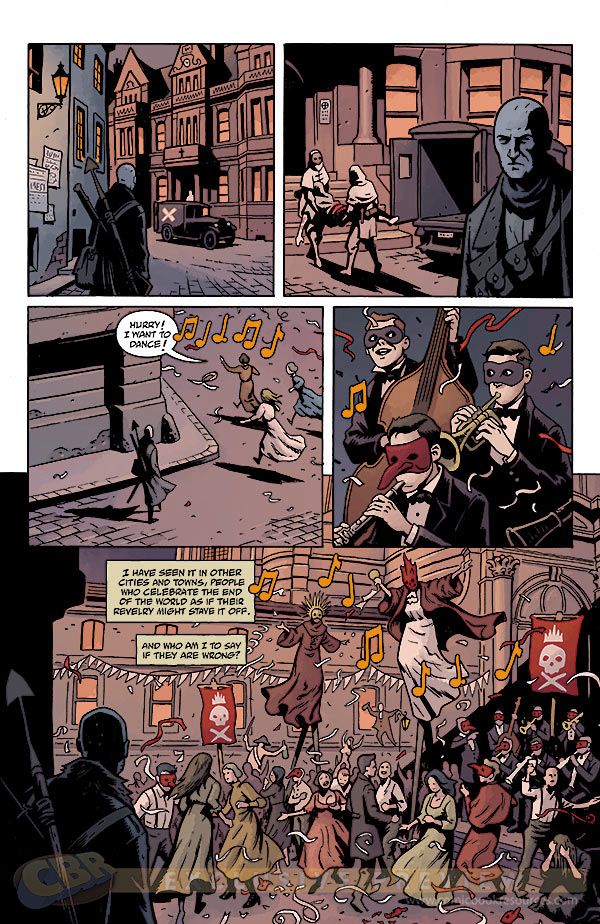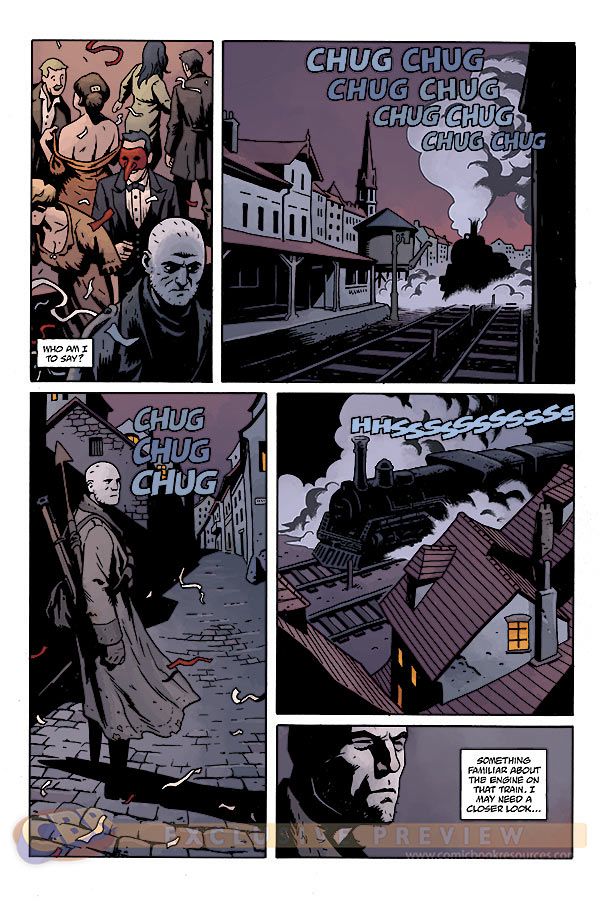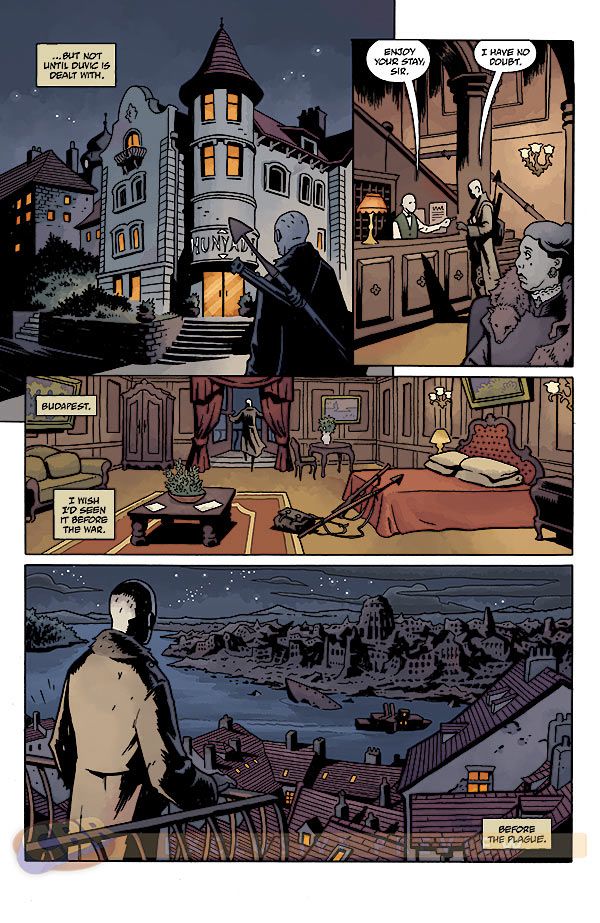Lord Henry Baltimore continues his relentless hunt for the vicious vampire king Haigus this fall in "Baltimore: The Infernal Trains," published by Dark Horse Comics. The three-issue miniseries, debuting September 4, is written by Mike Mignola and Christopher Golden and features art by Ben Stenbeck and colors by Dave Stewart.
Baltimore made his first appearance in 2007's illustrated novel "Baltimore, or The Steadfast Tin Soldier and the Vampire" by Mignola and Golden. The title character initially encounters Haigus on the battlefields of World War I, and that sets in motion a series of events that would dominate the remainder of his days. A plague of vampirism sweeps across Europe, and eventually everyone close to Baltimore succumbs -- dying at the hands of the plague or Haigus himself.
Dark Horse's series of "Baltimore" stories serve to illuminate a period of time not articulated in the novel, as Baltimore scours Europe in search of Haigus, slaying vampires along the way. The vampire hunter's first comic book appearance is collected in "Baltimore Volume 1: The Plague Ships." The hardcover edition, collecting the first five issues of the series, has gone back to press and will be available once again this August.
With "The Infernal Train," the hunter becomes the hunted, and Baltimore himself is pursued in turn. Following on the events of "Baltimore: The Inquisitor," "The Infernal Train" finds Baltimore biding his time in Budapest and planning to confront his pursuer, Judge Duvic, a 20th Century inquisitor bent on exacting God's wrath on the demons and monsters of the earth. Of course, who, or what, defines monstrosity is an open question -- often a definition based on perception.
Comic Book Resources spoke with series writer Christopher Golden, who hinted at developments to come in Baltimore's vampire hunting saga and touched on grief and damnation, vampire stories and episodic storytelling.
"As Baltimore has been pursuing Haigus, the ancient, scarred vampire who murdered his family, Baltimore himself has also been pursued," said Golden. "The guy on his tail is Judge Duvic, a priest and inquisitor in service to the New Inquisition. Duvic is, in his way, just as much a monster as Haigus -- and he believes Baltimore to also be a monster. These three men, or whatever they are, have one thing in common: Not one of them thinks of himself as a monster. Judge Duvic has not caught up with Baltimore, but he has killed at least one person close to Baltimore and nearly killed another. Before Baltimore can go on to destroy Haigus, he has to shake this nuisance who has been dogging his steps. But as those who read the recent one-shot, 'Baltimore: The Inquisitor' may suspect, Duvic has been altered by the events of that story. In 'The Infernal Train' Baltimore and Duvic will finally meet face to face in plague-ravaged Istanbul. But there is a third party to this conflict, one neither of them suspects."
While Baltimore is lying low in Istanbul, preparing to get the jump on Duvic, he encounters a strange woman who claims to possess a strange invention that is able to rid the world of the vampire plague. While essentially a stranger to Baltimore, the woman may be somewhat familiar to readers.
"While it's not necessary to have read any of the previous Baltimore stories, longtime readers may recognize Madame Fulcanelli from a very brief appearance in the first miniseries we did, 'The Plague Ships,'" said Golden. "She provides a service to communities, gathering and burning the plague dead, but of course there is more at work here than is evident on the surface. As for her relationship with Baltimore -- though they've crossed paths once before, this is the first time they'll meet."
It would seem that Baltimore ultimately has the upper hand on Duvic -- at least in their current circumstances. Duvic knows he is being pursued by the sadistic inquisitor and has set up for himself the terms of their meeting. To Baltimore, the judge is a roadblock -- a passing nuisance. His quest to destroy Haigus, however, hangs heavy over him.
"Baltimore perceives himself as doomed," Golden told CBR News. "Damned, really. And so he carries the weight of that everywhere he goes. Through his grief and his loss and the single-mindedness of his hunt, he has been forged into a weapon. Only now is he starting to believe that he has become a pawn in a battle between forces far beyond him, but he's ignoring it. He's focused on one thing and one thing only, and that's the destruction of Haigus. To Baltimore, Judge Duvic is a distraction -- but a dangerous distraction."
Ben Stenbeck is returning to art duties on "Baltimore: The Infernal Train," lending Baltimore's world both grounding complexity and atmosphere. Golden credits Stenbeck for truly bringing the world, and its characters, to life.
"Ben is brilliant. Far too often in writing a comic book script, you envision something grand and textured and it doesn't turn out anywhere near as beautiful and weighty as you imagined. Ben does the opposite; every issue is better than I imagined it while writing," Golden said. "Mike and I have imagined this world, but Ben's art and Dave Stewart's colors have made it breathe... Ben gives our locations character unto themselves. He does the research. As for Baltimore the man -- he's a stoic S.O.B. But we've managed to sneak in some moments of dry humor and even exasperation along with the usual sorrow and fury, and Ben pulls those things off beautifully. To me, that is the shape of the world: being able to drag you in and give you a real sense of place."
"Baltimore" follows a somewhat atypical publishing schedule: rather than a continuous, ongoing series, or even the monthly set of miniseries à la "B.P.R.D.," "Baltimore emerges as fairly regular installments varying in length from single issue stories to longer multi-issue arcs. Golden works closely with Mike Mignola in writing the stories, working through outlines and drafts in tight collaboration. All those short stories, offering glimpses into Baltimore's wider world, are definitely building up to something larger.
"On the 'Baltimore' comics, Mike and I have frequent conversations about the direction we want to take it," said Golden. "Most of the individual plots we dreamed up ages ago -- at least everything up to the end of volume four. I beat it into shape as a brief outline and once we're both happy with it --and [Editor-in-Chief] Scott Allie gives his thumbs up -- I do the first drafts, get Mike's feedback and tweak accordingly.
"Mike and I share a lot of the same interests and frame of reference," continued Golden. "Old folklore, old monster stories, crumbling monasteries, Hammer movies and just out-and-out weird shit. It's no accident that Poe and Madame Blavatsky show up in 'Baltimore,' or that our first story in the comics had a graveyard of sunken submarines full of plague zombies... Each story takes on its own identity, its own proper size. 'Dr. Leskovar's Remedy' needed to be two issues. 'The Inquisitor' only needed to be one. In volume three, we wanted a selection of stories of varying lengths that would provide other small glimpses into Baltimore's world, moments that established tone, and some stories that would give us an opportunity to delve more into the villains -- Haigus and Judge Duvic. At the same time, there is a single story building in the background of everything. Some stories contribute directly to moving that narrative forward and some contribute indirectly. There's an ebb and flow, but we're mainly guided by instinct, just as a novelist is with plotting out a novel...Longer stories tend to be more operatic, but a short vignette is more like a poem. There's a spare quality to them that can sometimes make the knife cut more deeply."
"Baltimore" is a story full of vampires, following the trials of a vampire hunter. The vampire has been around for hundreds of years, at least. It's been the subject of countless myths and narratives and seems to be in no danger of fading anytime soon. Even with the plethora of vampire stories out there, it's entirely possible to present a fresh take on the genre, said Golden, providing one insists on story first.
"It's simply got to be a story first and a vampire story second," said Golden. "Mike and I have always talked in a general sense about the novel being a 'vampire novel,' but the overall story of Baltimore, including the comic book series, isn't really a vampire story in our eyes. It's a story about a man doomed by chance, damned by his own hatred and grief, and out for vengeance in a world infected with plague and slowly being reclaimed by the monsters of its past. For our supernatural stuff, we look at myth and folklore, take what we like and then do whatever we feel like doing with it. It's absolutely possible to tell fresh vampire stories in the sense that it's always possible to tell fresh stories. They just have to be your stories with your perspective."
In discussing the events to come in "The Infernal Train," and the pending confrontation between Baltimore and Judge Duvic, Golden hinted at some possible changes in Duvic's character as a result of the events taking place in "Baltimore: The Inquisitor." While Golden remains reluctant to say too much too soon, it would seem that Duvic might have had his faith in his cause shaken in that cellar dungeon. Perhaps the showdown Baltimore is expecting will pan out in unexpected ways.
"All I'll say is that in 'The Inquisitor' [Duvic] is forced to consider himself from someone else's perspective and to wonder if he is perhaps not the man he'd thought he was," said Golden. "For a righteous man to contemplate his own iniquities -- well, how can that not change a person?"
"Baltimore: The Infernal Train" begins Sept. 4.





